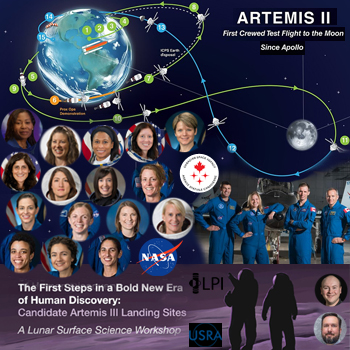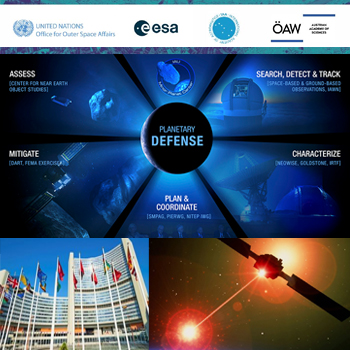Artemis 2 Astronauts to be Announced as LSSW #19 Workshop Continues Artemis 3 Candidate Landing Site Analyses
|
MONDAY☆ Apr 3 — International Space Station, ~415-km LEO: Expedition 69 working with Vascular Aging 13-hour blood pressure studies, and cargo from Dragon CRS-27, Progress 83P, Cygnus ‘SS Sally Ride‘ NG-18. ☆ Apr 3 — Tiangong Space Station, ~390-km LEO: Shenzhou-15 crew may perform 1-2 more EVAs over next 2 months; CMSA is working on 25-kg taikobot to help aboard space stations & other applications. Highlights… o NewSpace: Crescent Space Systems, subsidiary of Lockheed, to work on cislunar comm & navigation network ‘Parsec’; Launch provider Equatorial Space of Singapore to advance Dorado rocket with $1.5M; Space Pioneer planning Tianlong-2 first operational liquid-fueled orbital flight in April. ☆ Solar System: Water-containing glass globules returned to Earth via Chang’E-5 may indicate source of lunar surface water; Hubble Outer Planet Atmospheres Legacy (OPAL) program monitoring changing weather patterns on Jupiter and Uranus in 12th year; NASA VERITAS Venus mission faces uncertain future amid funding shortfall. ☆ Galaxy: TRAPPIST-1b appears to have little-to-no atmosphere according to JWST observations, other 6 known exoplanets to be analyzed; Astronomer Bernard Carr posits existence of primordial black holes which predate Big Bang; Correlation between radio CHIME and gravity wave LIGO data suggests neutron star origin of some FRBs. o Global: UN Methane Alert and Response System to begin disclosing 40-50 leaks per month over 10,000 kg/hr threshold observed by Kayrros & SRON; Cross-referenced China Insight-HXMT / SATech-01, USA Fermi, & Russia Konus data show Gamma Ray Burst 221009A was 70x more energetic than any previously observed. ● USA: Redesigned RS-25 engine models with 30% reduced cost, ~110% increased thrust and slated for Artemis 5 being tested at Stennis; Astronaut Frank Rubio to set national record of ≥ 371 continuous days in space with NET Sept 27 return to Earth; Parachute review further delays Boeing Starliner inaugural crewed spaceflight to NET July 21. ● Hawai’i: Lānaʻi Elementary teacher Danyel Erickson and student Shaia Costales recount exchange with Crew-6 Astronaut Warren Hoburg from ISS; TMT Director Robert Kirshner “optimistic” about Mauna Kea astronomy ahead of MKSOA operations beginning in July; Art meets astronomy with new mural by UH student Cyan Garma adorning IfA courtyard. |
 |
● = Terrestrial and… o = International terrestrial events
☾ = Moon activity ★ = Space and… ☆ = International space / astro events in Hawaii Standard Time unless noted. Add 10 hours to obtain UT (‘Universal Time’). |
Weekly Planet Watch – Morning Planets: Saturn (ESE); Evening Planets: Mercury (W), Venus (W), Mars (W), Uranus (W).
International Academy of Astronautics Planetary Defense Conference Meets in New Era of Astronomical Engineering
|
o Apr 3 — NASA, Johnson Space Center, Canadian Space Agency, Online / Houston TX: Announcement of the 4-member crew to fly on Artemis 2 mission around the Moon and back to Earth; 11:00 EDT, live coverage available. o Apr 3-7 — International Academy of Astronautics, United Nations Office for Outer Space Affairs (UNOOSA), ESA, Vienna, Austria: 8th IAA Planetary Defense Conference. ☆ Apr 3 — Apollo Asteroid 2023 EA2: Near-Earth Flyby (0.058 AU) Continued From… ● Oct 15 – Jun 15, 2023 — International Space Elevator Consortium, Online: Space Elevator Academic Challenge: Improving Humanity’s Future; for students 17-25. ☾ Dec 11 – Apr 25, 2023 — Hakuto-R / ispace Mission 1, Lunar Landing Trajectory: Carrying UAE Rashid 10-kg rover, 0.25-kg JAXA SORA-Q rover, Hakuto-R performing orbital control maneuvers to reach Lunar Orbital Insertion, followed by Moon touchdown nominally ~4.5 months after launch. ● Jan 18 – May 11 — Wichita State University, Wichita KS and Online: 2023 Interstellar Seminar ‘LASI 150G’; 1-credit hour seminar begins today; every Wednesday 14:30-15:20, led by Prof. Mark Schneegurt. o Feb 24 – May 24 — National Museum of China, Beijing, China: Exhibit Featuring China’s Human, Lunar and Space Program. ☆ NET Apr — Gilmour Space, Launch Eris, Bowen Orbital Spaceport, Queensland, Australia: Inaugural flight of 23-m / 30,000-kg solid fueled rocket, first Australia domestic orbital launch. o NET Apr — ESA, Cologne, Germany: Start of Training – New Astronaut Class of 2022; at European Astronaut Centre. TUESDAY● Apr 4 — Maryland Space Business Roundtable (MSBR), Greenbelt MD: MSBR Luncheon with Trudy Kortes, (Director of Technology Demonstrations in STMD); 11:30-13:00. ● Apr 4-5 — Lunar and Planetary Institute, NASA, USRA, Online / Houston TX: Lunar Surface Science Workshop #19: The First Steps in a Bold New Era of Human Discovery – Candidate Artemis III Landing Sites. ☆ Apr 4 — Apollo Asteroid 2004 OW10: Near-Earth Flyby (0.055 AU) ☆ Apr 4 — Amor Asteroid 2023 FQ2: Near-Earth Flyby (0.058 AU) |
WEDNESDAY
● Apr 5 — Mitchell Institute for Aerospace Studies, Arlington VA: 2nd Spacepower Security Forum.
☆ Apr 5 — Moon: Full Pink Moon, 18:36.
THURSDAY
☆ Apr 6 — ISS, Relocation of Soyuz MS-23, ~415-km LEO: Relocation of Soyuz MS-23 spacecraft with NASA Flight Engineer Frank Rubio and Roscosmos Flight Engineers Sergey Prokopyev and Dmitri Petelin from Poisk module to Prichal module; 04:15 EDT, live coverage available.
● Apr 6 — LPI, USRA, Hybrid / Houston TX and Online: Presentation: A Revolution in Solar System Astronomy with JWST; by Ian Wong (Goddard Space Flight Center), start 19:30 CDT.
☆ Apr 6 — Moon: 2.95° NNE of Spica, 11:00.
☆ Apr 6 — Apollo Asteroid 2023 FM: Near-Earth Flyby (0.020 AU)
☆ Apr 6 — Amor Asteroid 2023 FE4: Near-Earth Flyby (0.024 AU)
☆ Apr 6 — Apollo Asteroid 2023 FZ3: Near-Earth Flyby (0.027 AU)
FRIDAY
★ Apr 7 — SpaceX, Launch Falcon 9 / Intelsat 40e/TEMPO6, LC-40, Cape Canaveral SFS FL: Falcon 9 to launch Intelsat 40e communications satellite for Intelsat; first stage booster to land on drone ship in Atlantic Ocean.
☆ Apr 7 — Aten Asteroid 2018 FD: Near-Earth Flyby (0.045 AU)
SATURDAY
☆ Apr 8 — Apollo Asteroid 2011 WP4: Near-Earth Flyby (0.057 AU)
☆ Apr 8 — Apollo Asteroid 2022 UE28: Near-Earth Flyby (0.059 AU)
☆ Apr 8 — Apollo Asteroid 511777 (2015 EZ): Near-Earth Flyby (0.095 AU)
SUNDAY
★ Apr 9 — SpaceX, Launch Falcon 9 / Transporter 7, SLC-4E, Vandenberg SFB CA: Falcon 9 to launch Transporter 7 mission to SSO with many microsatellites and nanosatellites for commercial and government customers; first stage booster to return to Landing Zone 4.
☆ Apr 9 — Moon: 1.49° NNE of Antares, 22:00.
☆ Apr 9 — Amor Asteroid 2023 EQ: Near-Earth Flyby (0.055 AU)
☆ Apr 9 — Amor Asteroid 2023 FR2: Near-Earth Flyby (0.073 AU)
☆ Apr 9 — Aten Asteroid 2022 BY39: Near-Earth Flyby (0.076 AU)

